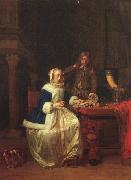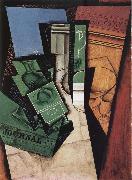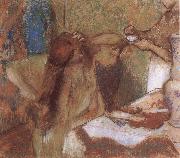
Oil On
Canvas, Real Flavor of Old Masters
|
Gabriel Metsu
|
|||
|
|
|||
| 1629-1667 Dutch Gabriel Metsu Galleries One of his earliest pictures is the "Lazarus" at the Strassburg Museum, painted under the influence of Jan Steen. In 1653 under the influence of Rembrandt he painted "Woman taken in Adultery," a large picture which is now in the Louvre. To the same period belong the "Departure of Hagar," formerly in the Thore collection, and the "Widow's Mite" at the Schwerin Gallery. But he probably observed that sacred art was ill suited to his temper, or he found the field too strongly occupied, and turned to other subjects for which he was better fitted. That at one time he was deeply impressed by the vivacity and bold technique of Frans Hals can be gathered from Lord Lonsdale's picture of "Women at a Fishmonger's Shop." What Metsu undertook and carried out from the first with surprising success was the low life of the market and tavern, contrasted, with wonderful versatility, by incidents of high life and the drawing-room. In no single instance do the artistic lessons of Rembrandt appear to have been lost upon him. The same principles of light and shade which had marked his schoolwork in the "Woman taken in Adultery" were applied to subjects of quite a different kind. A group in a drawing-room, a series of groups in the market-place, or a single figure in the gloom of a tavern or parlour, was treated with the utmost felicity by fit concentration and gradation of light, a warm flush of tone pervading every part, and, with that, the study of texture in stuffs was carried as far as it had been by Ter Borch or Gerard Dou, if not with the finish or the brio of De Hooch. One of the best pictures of Metsu's manhood is the "Market-place of Amsterdam," at the Louvre, respecting which it is difficult to distribute praise in fair proportions, so excellent are the various parts, the characteristic movement and action of the dramatis personae, the selection of faces, the expression and the gesture, and the texture of the things depicted. Equally fine, though earlier, are the "Sportsman" (dated 1661) and the "Tavern" (also 1661) at the Hague and Dresden Museums, and the "Game-Dealer's Shop," also at Dresden, with the painter's signature and 1662. Gabriel Metsu, Man Writing a Letter (1662-1665), Oil on canvas, National Gallery of Ireland, DublinAmong the five examples of the painter in the Wallace Collection, are "The Tabby Cat," and "The Sleeping Sportsman," which cost Lord Hertford £ 3000, is an admirable example technically considered. Among his finest representations of home life are the "Repast" at the Hermitage in St Petersburg; the "Mother nursing her Sick Child" in the Rijksmuseum in Amsterdam; the "Amateur Musicians" at the Hague Gallery; the "Duet" and the "Music Lesson" at the National Gallery, London, and many more examples at nearly all the leading European galleries. Five of his painting are in Dresden, collected by August the Strong. | |||
|
|
|||
|
|
Breakfast Gabriel Metsu1.jpg Painting ID:: 2875 Visit European Gallery |
1660 The Hermitage, St.Petersburg | |
Height Width |
INS/CM |
||
|
X |
|
||
|
|
|||
|
Hills, Laura Coombs
|
|||
|
|
|||
| American Miniaturist, 1859-1952 | |||
|
|
|||
| This artist (Hills, Laura Coombs) is not available now. | |||
|
|
|||
|
Juan Gris
|
|||
|
|
|||
| 1887-1927 Born in Madrid, he studied mechanical drawing at the Escuela de Artes y Manufacturas in Madrid from 1902 to 1904, during which time he contributed drawings to local periodicals. From 1904 to 1905 he studied painting with the academic artist Jose Maria Carbonero. In 1906 he moved to Paris and became friends with Henri Matisse, Georges Braque, Fernand Leger, and in 1915 he was painted by his friend, Amedeo Modigliani. In Paris, Gris followed the lead of another friend and fellow countryman, Pablo Picasso. His portrait of Picasso in 1912 is a significant early Cubist painting done by a painter other than Picasso or Georges Braque. (Although he regarded Picasso as a teacher, Gertrude Stein acknowledged that Gris "was the one person that Picasso would have willingly wiped off the map.") Portrait of Picasso, 1912, The Art Institute of Chicago.Although he submitted darkly humorous illustrations to journals such as Le Rire, L'assiette au beurre, Le Charivari, and Le Cri de Paris, Gris began to paint seriously in 1910. By 1912 he had developed a personal Cubist style. At first Gris painted in the analytic style of Cubism, but after 1913 he began his conversion to synthetic Cubism, of which he became a steadfast interpreter, with extensive use of papier coll??. Unlike Picasso and Braque, whose Cubist works were monochromatic, Gris painted with bright harmonious colors in daring, novel combinations in the manner of his friend Matisse. In 1924, he first designed ballet sets and costumes for Sergei Diaghilev and the famous Ballets Russes. Gris articulated most of his aesthetic theories during 1924 and 1925. He delivered his definitive lecture, Des possibilit??s de la peinture, at the Sorbonne in 1924. Major Gris exhibitions took place at the Galerie Simon in Paris and the Galerie Flechtheim in Berlin in 1923, and at the Galerie Flechtheim in D??sseldorf in 1925. He died in Boulogne-sur-Seine (Paris) in the spring of 1927 at the age of forty, leaving a wife, Josette, and a son, Georges. | |||
|
|
|||
|
|
Breakfast new10/Juan Gris-433926.jpg Painting ID:: 36537 Visit European Gallery |
mk112 1915 92x73cm | |
Height Width |
INS/CM |
||
|
X |
|
||
|
|
|||
|
Edgar Degas
|
|||
|
|
|||
| French Realist/Impressionist Painter and Sculptor, 1834-1917 French painter, draughtsman, printmaker, sculptor, pastellist, photographer and collector. He was a founder-member of the Impressionist group and the leader within it of the Realist tendency. He organized several of the group exhibitions, but after 1886 he showed his works very rarely and largely withdrew from the Parisian art world. As he was sufficiently wealthy, he was not constricted by the need to sell his work, and even his late pieces retain a vigour and a power to shock that is lacking in the contemporary productions of his Impressionist colleagues. | |||
|
|
|||
|
|
Breakfast new18/Edgar Degas-997429.jpg Painting ID:: 49991 Visit European Gallery |
mk206 1896-1899 Oil on canvas 96x110cm | |
Height Width |
INS/CM |
||
|
X |
|
||
|
|
|||









